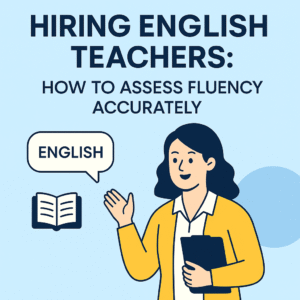My first attempt at using AI for speaking assessment was a mess. Half the class couldn’t log in, three students forgot their headphones, and the background noise made the results unusable. But here’s the thing – by the end of that week, those same tools had saved me countless hours of one-on-one assessment time.
Let me share what I learned the hard way.
The Reality of Language Assessment Today
If you’re like most language teachers, you’re drowning in speaking assessments. I used to stay late every Tuesday and Thursday, listening to student recordings and scribbling feedback. The worst part? By the time students got my comments, they’d forgotten what they’d said in the first place.
IIs AI the perfect solution? Not yet. But after reviewing insights from the study “Generative AI and Language Education: Opportunities, Challenges, and the Need for Critical Perspectives”, it’s evident that AI is changing how we handle speaking practice. For students who struggle with speaking anxiety, understanding the unique challenges of oral expression is critical to making AI tools effective.. Some days it works like magic, other days you’ll want to throw your laptop out the window. Let’s talk about both.
What’s Actually Working in Classrooms
Here’s something they don’t tell you in the marketing materials – AI tools aren’t replacing good teaching. They’re just handling the grunt work. Take pronunciation feedback. During a recent class observation in Denver, I watched students get immediate feedback on their ‘th’ sounds. The teacher? She was free to work with students who needed extra help.
But, the transition isn’t always smooth. One teacher told me, “The first month was rough. The AI kept misunderstanding my Spanish-speaking students. We had to learn which accents it handled well and which needed human ears.” Now she uses a mix of AI assessment and personal feedback, especially for students with strong accents.
The game-changer isn’t the technology itself – it’s the time it gives back. Teachers are using those extra hours for what matters: actual conversation practice, personalized help, and building student confidence.
Finding Your Way Through the Tech Maze
No one tells you about the weird tech hiccups. Last semester, I watched a veteran teacher struggle because her classroom’s concrete walls blocked WiFi signals. Her solution? She moved speaking practice to the library. Not ideal, but it worked. These are the real-world fixes you discover through trial and error.
Privacy concerns keep coming up in department meetings. Parents ask tough questions about voice recording storage. One school solved this by having an open house where they showed exactly how AI assessment tools work. Transparency helped. Though some parents still opted out, most felt better seeing the process firsthand.
Not every AI tool works the same way. Some handle background noise better than others. Some struggle with younger voices. Learn more about the different types of AI tools for language learning to find the best fit for your classroom. Testing different options with a small group first saves headaches later. As one frustrated colleague put it, “I wish someone had told me to start with just five students instead of my whole class.”
When Things Don’t Go As Planned
Let’s talk about what the promotional materials don’t mention. Sometimes the internet crashes mid-assessment. Sometimes students forget passwords. And yes, sometimes the AI completely misunderstands what your students are saying.
A teacher in Chicago shared this gem: “The AI gave a perfect score to a student who was clearly reciting a grocery list in Spanish instead of giving his English presentation.” We laughed, but it taught us something important – AI tools need oversight. They’re assistants, not replacements.
The key is having a backup plan. Keep traditional assessment rubrics handy. Be ready to switch to peer review activities. When technology fails (and it will), you need options that don’t require an internet connection.
Measuring Real Progress (Not Just Numbers)
Here’s what surprised me most – the numbers don’t tell the whole story. Sure, the AI spits out impressive-looking graphs and scores. But the real progress shows up in unexpected ways.
Take Maya’s class. Their average pronunciation scores barely moved for weeks. But suddenly students were volunteering to speak in class. They were using English during group work without being prompted. The AI hadn’t captured these changes, but they mattered more than any percentage improvement.
Smart teachers look beyond the data. They watch for raised hands, for conversations that spill into the hallway, for students teaching each other. One teacher keeps a simple journal: “Today Adam explained directions to a new student without switching to Spanish.” These moments matter more than any algorithm can measure.
Making It Work (Without Losing Your Mind)
Start small – that’s my biggest takeaway after watching dozens of teachers adopt AI tools. Pick one activity, one class, one skill to focus on. The eager teachers who tried changing everything at once? Most gave up within weeks.
I watched a first-year teacher try to implement daily AI speaking assessments. By week two, she was overwhelmed. Now she uses AI for Friday pronunciation checks only. Her students get the benefit of regular feedback without the stress of constant tech management.
“I thought more technology meant better teaching,” she told me. “But it’s about finding the right balance for your teaching style and your students’ needs.”
Looking Forward (With Both Eyes Open)
AI language tools are evolving fast. One month they struggle with teenage voices, the next they handle them perfectly. But here’s what experienced teachers know – don’t chase every new feature. Wait for the ones that solve your specific classroom challenges.
Some promising developments are worth watching. Tools are getting better at understanding regional accents. They’re learning to assess natural conversation rather than just prepared speeches. But remember – good teaching still matters more than good technology.
Finding Your Next Steps
You’ve heard both the wins and struggles. Maybe you’re ready to try AI in your classroom. Maybe you’re still skeptical. Both reactions make sense. Here’s what matters: anything that gives teachers more time to actually teach deserves careful consideration.
Several AI-powered platforms, including Fluency Flow, offer ways to explore speaking assessment tools. Start with a small pilot. Fluency Flow’s detailed feedback and assessment tools have helped educators save time while improving classroom outcomes. See what works in your specific context. You might find, like many teachers have, that the right tool at the right time can transform your teaching practice.
Want to learn more about implementing AI speaking assessment in your classroom?
Visit Fluency Flow’s resource center for practical guides, lesson plans, and real teacher stories. Or join our community of educators sharing their experiences with AI tools in language teaching.
Because at the end of the day, it’s not about perfect technology. It’s about finding better ways to help our students find their voice in a new language.




